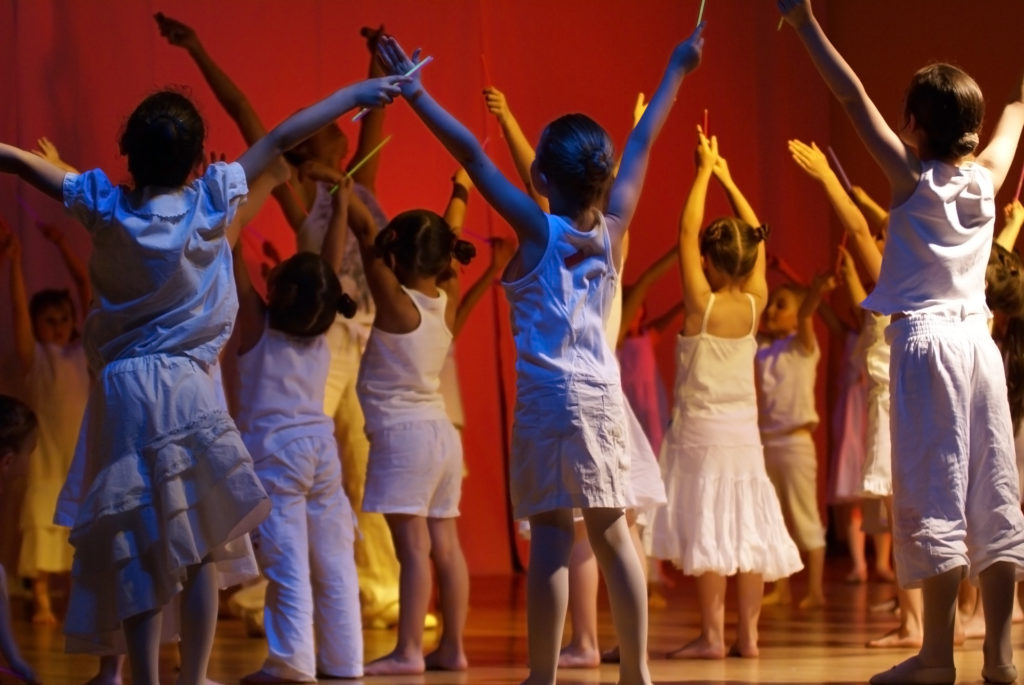How to Sustain Cultural Art Forms in Arts Education Equitably

This photo features a group of children on an indoor stage performing a dance. The children wear white clothing, some in skirts, shorts and short pants, as well as sleeveless and short-sleeved shirts. The photo captures them with raised arms and in a circle around their instructor. The children posed in the foreground have their backs to the audience and the photographer. They are holding small, colored wands. Credit: Adobe Stock Photo.
We were co-teachers of neo-traditional West African dance in an urban elementary school. Avalon, the classroom teacher, trained in the academy. Ms. Jeannine, the cultural expert, learned traditionally and trained in the academy. Recently, we wrote about our partnership in an article that details folk arts pedagogy and co-teaching methods that result in positive school equity impacts. Here we propose some open-ended questions to inspire teachers and school administrators to consider how arts education programming and policy are often at odds and what changes would ensure a more equitable path forward in education decision-making.
Across the country, some schools invite historically neglected voices into the school community through arts education and arts integration programs. These experiences may be designed to sustain and align with school improvement plans, reduce barriers to learning for students, increase access to the arts and dismantle systemic racism. However, teaching artists are often excluded from planning these initiatives, resulting in watered-down cultural experiences that can harm student understanding.
School leadership and arts administrators should carefully consider how insufficient funding — often combined with insufficient critical literacy of art forms that carry significant cultural context — can contribute to dismantling traditions. One example is African drumming and dance programming, which is not honored when decision-makers invite or fund one art form – dance – and not the other – drumming.
What can be learned by including experienced teaching artists in arts integration planning and inviting co-teaching into the classroom?
Jeannine: I have been an expert teaching artist of diasporic African drum and dance traditions for close to 40 years. I was born during the Civil Rights, Black Freedom and African Independence Movements, in which neo-traditional drum and dance served as a voice of the people. Drummers and dancers trained to be ‘Keepers of the Culture’ embody Black history and Black knowledge and reach schools and institutions through arts education.
Some schools and organizations develop meaningful, decades-long relationships with cultural experts, while others do not. For example, consider the vital role that drummers serve in an African dance program that teaches from a cultural perspective. As a ‘Keeper of the Culture’, I require a drummer and drums in my diasporic African drum and dance practice. As a cultural expert, I have a responsibility for how cultural traditions are transmitted. We teach more than steps.
The spirit of collaboration and equity that we developed co-teaching at an elementary school models the promise of arts education that needs additional attention in teacher training and research. Collaboration makes the experience more authentic for the students, creates a stronger connection to curricular goals for the classroom and ensures that the art form and artists are honored. By including teaching artists and culture bearers from the beginning stages of partnerships, educational institutions can honor the art forms these educators teach and offer well-rounded, culturally relevant student learning that supports anti-racist education goals.
Here we extend what we learned to propose some open-ended questions that can inspire teachers and decision-makers to consider how arts integration and policy might be at odds — especially when it comes to funding and partnerships — and what changes can encourage an equitable relationship between the two.
- What non-Western cultural art forms experience a lack of sufficient support and understanding, potentially harming cultural understanding and teaching artist inclusion and funding?
- In what ways can classroom teachers, who are at the frontline of collaboration and co-teaching, work with administrators to ensure community teachers and artists are fully included?
- How can policy support arts integration and teaching artists as authentically and equitably as possible?
- How can classroom teachers expand required curricula to engage students innovatively and creatively through folk and traditional arts?
- What are the art forms in students’ cultural communities?
We encourage all educators to consider what art forms may be a part of each of your students’ cultural communities when developing arts education programming. By reflecting upon our questions and co-teaching experience, we hope that schools and teachers plan, fund and write curriculum differently so that more students see their art, elders and cultural knowledge embedded in school spaces.
To learn more about folk and traditional arts education or read articles from the special issue on Teaching for Equity published by the Journal of Folklore and Education, visit Local Learning: The National Network for Folk Arts in Education.



